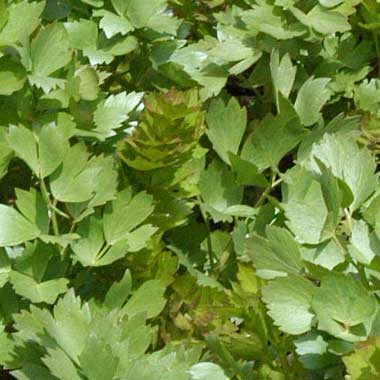


Lovage
Levisticum officinale

A vigorous herb ideal for planting at the back of the border,
it is very useful in spring as it starts growing early in February.
The tender shiny leaves taste rather like peppery celery and can be chopped into salads to brighten up winter meals.
The seeds produced in late summer have an even stronger flavour and dry well for winter use.
In earlier times the young shoots were blanched in early spring and the shoots used as a vegetable.
Nowadays the young leaves are chopped into salads, added to soups and stews to give them zest,
and also added to roasting meats.
The flavour pairs well with strong tasting vegetables such as celeriac, fennel and other roots.
The young stems can be candied rather like angelica, and the seeds can be used right through the year in bread,
cakes and biscuits.
Tangy Spring Salad
- 1 little gem lettuce – shredded
- a handful of rocket leaves
- 3 tomatoes – seeded and chopped.
- 4 tbs chopped lovage leaves
- 1 small red onion
- 8 'ready to eat' dried apricots - halved
- 1 red pepper - seeded and cut into 2 cm dice
- olive oil
Toss the pepper in a little olive oil and roast in the oven at Gas Mark 6, 200C, 400F until starting to brown,
about 7 – 10 minutes.
Add the pepper pieces to the other salad ingredients in a serving bowl and mix well.
Serve with a dressing made from 4 tbs olive oil, 2 tbs orange juice,
1 clove of finely chopped garlic and freshly ground black pepper.
Since medieval times lovage has been known as a ‘bath’ herb, as it cleanses and deodorises the skin. Lovage broth, made from the seeds or leaves, is a diuretic and stimulates the appetite.